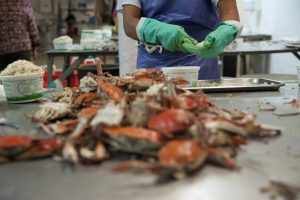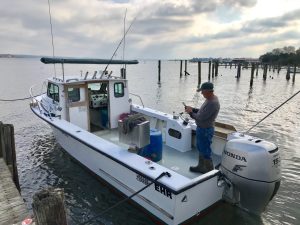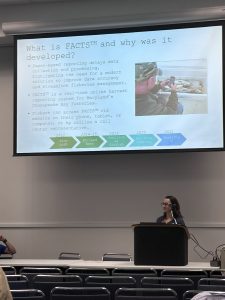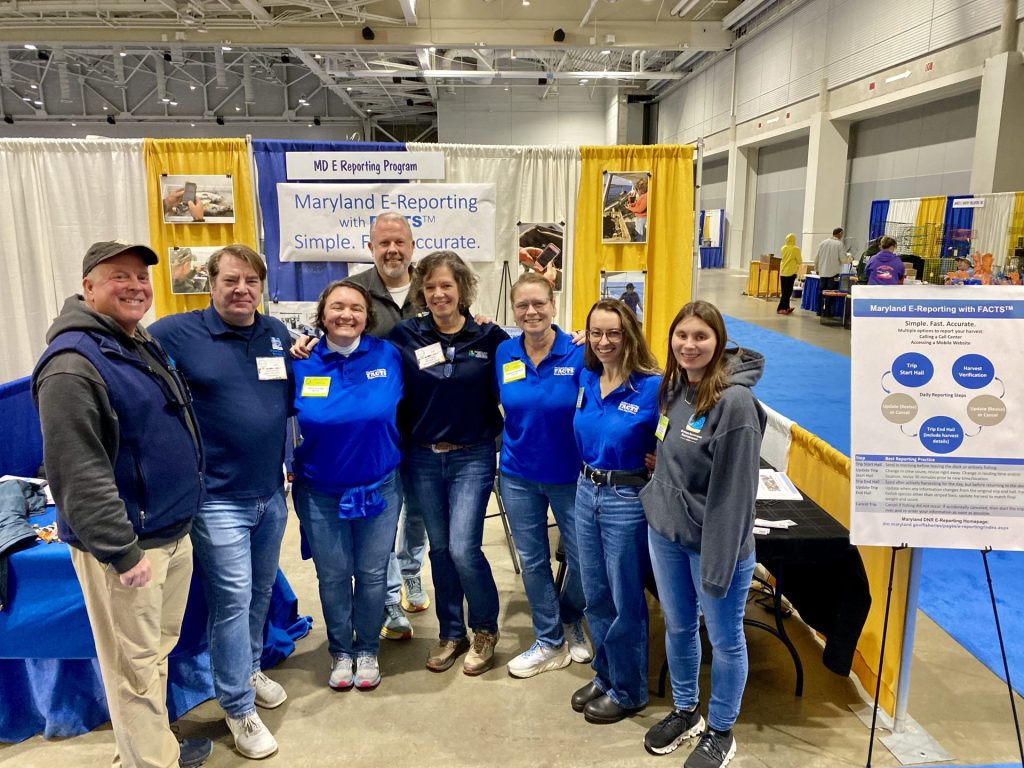Accurate seafood purchase and sales reporting is essential for managing sustainable fisheries. Across the Chesapeake Bay, seafood dealers use a variety of methods to report transactions, some of which can create challenges for timely and efficient data collection. To better understand what’s working, what’s not, and where there’s room for improvement, the Oyster Recovery Partnership partnered with regional agencies and stakeholders. Together, we explored options that support both seafood businesses and fishery managers. Here’s what we found.

Steamed blue crab ready for processing at Bay Hundred Shucking House.
Every day, seafood dealers across the Chesapeake Bay help bring local catch to restaurants, markets, and consumers. These businesses buy seafood directly from harvesters and may also process, distribute, or serve it. Behind the scenes, reporting seafood purchases can be complicated, outdated, and inconsistent. Accurate reporting helps ensure the seafood we enjoy is responsibly harvested and traceable from water to plate.
Many seafood dealers in Maryland, Virginia, and the Potomac region still largely rely on paper forms to report their purchases. These reports are mailed or faxed once a month and must be processed manually by state staff. This creates delays, increases the risk of errors, and makes it harder for agencies to verify harvests, track quotas, and sustainably manage fisheries.

Crab meat being hand-picked for packaging and sale at Bay Hundred Shucking House.
To better understand the challenges and explore solutions, ORP partnered with the Maryland Department of Natural Resources, the Virginia Marine Resources Commission, and the Potomac River Fisheries Commission. With support from the National Marine Fisheries Service, we conducted surveys, interviews, and meetings with more than 60 participants, including 41 seafood businesses and over 20 agency staff representing science, enforcement, IT, public health, and fisheries management.
This effort would not have been possible without the direct input of seafood dealers who shared their time and experiences. Participants represented a range of business types and sizes, from small family-run operations and mobile raw bars to processors and large wholesale distributors. We are grateful to everyone who contributed. Their insights directly shaped the findings and recommendations in the final report.
WHY IT MATTERS

A waterman reports harvest using Maryland’s FACTS™ system, which improves efficiency and allows catch reporting by phone, tablet, or call center.
 Trip-level electronic reporting means recording seafood purchases after each individual fishing trip, rather than summarizing them at the end of the month. This approach is similar to how paper buy tickets are currently used in the shellfish industry. For example, oyster dealers fill out a ticket for each purchase, capturing harvest details that support public health tracking, tax collection, and traceability. Electronic reporting would apply that same level of detail more broadly across more species and in a digital format. It gives agencies a timely and accurate view of landings and sales, improves their ability to verify harvests and enforce quotas, and reduces reporting errors. It can also help dealers cut down on paperwork and stay better organized.
Trip-level electronic reporting means recording seafood purchases after each individual fishing trip, rather than summarizing them at the end of the month. This approach is similar to how paper buy tickets are currently used in the shellfish industry. For example, oyster dealers fill out a ticket for each purchase, capturing harvest details that support public health tracking, tax collection, and traceability. Electronic reporting would apply that same level of detail more broadly across more species and in a digital format. It gives agencies a timely and accurate view of landings and sales, improves their ability to verify harvests and enforce quotas, and reduces reporting errors. It can also help dealers cut down on paperwork and stay better organized.
LESSONS LEARNED

ORP’s Fisheries Program Manager highlights electronic reporting and invites industry participation in the seafood dealer scoping study at the Maryland Watermen’s Association (MWA) Trade Exposition in January 2025.
Here are a few key takeaways from the project:
- There is strong interest in electronic reporting. Many dealers and managers see the value of faster, more reliable systems that reduce paperwork.
- Current systems face limitations in meeting the full scope of today’s fisheries reporting needs. Paper-based processes can lead to delayed submissions, incomplete data, and an added workload for both businesses and agency staff.
- Dealers want flexible tools. Desired features include offline access, QuickBooks integration, prefilled fields, and the ability to generate automated receipts or summaries. Some dealers already use digital tools for transactions, inventory, or tax documentation and want reporting systems that align with their current workflows.
- Managers need better tracking tools. Trip-level data would help agencies cross-check harvest reports, monitor quota-managed species, improve stock assessments, and support accountability and compliance efforts.
WHAT IS ALREADY UNDERWAY

Waterman hand tonging for oysters in Eastern Bay, Maryland. Photo by Jordan Salafie.
Maryland has begun testing a small-scale shellfish dealer reporting module through its Fishing Activity and Catch Tracking System (FACTSTM). Only a few dealers are currently using it. However, the pilot demonstrates potential for broader application, including expansion to other fisheries beyond shellfish. Some dealers also use federal platforms like SAFIS or third-party tools such as BlueTrace or Trace Register, which offer digital tracking and could be adapted for state-level reporting needs.
WHAT COMES NEXT
The report outlines a path forward for improving dealer reporting in the Chesapeake Bay, not through one centralized regional system but through compatible, flexible tools that integrate with existing business systems and address the specific needs of each agency and dealer. By coordinating shared data fields, system design, and training, agencies can streamline the process for businesses that operate across jurisdictions while still maintaining their own reporting systems. These efforts also align with the Atlantic Coastal Cooperative Statistics Program (ACCSP), which supports data standardization and collaboration across the Atlantic coast.
Next steps include piloting new tools with dealers, gathering feedback, and providing the training and support needed to ensure long-term success. At its core, this work is about reducing burdens on dealers, improving data quality, and strengthening fisheries management. Smarter reporting also enhances traceability and supports a more resilient and transparent seafood supply chain.
Read the full report here

FACTS™ E-Reporting booth at the MWA Trade Exposition, used to promote the program, offer training, and raise awareness about the seafood dealer scoping study.
